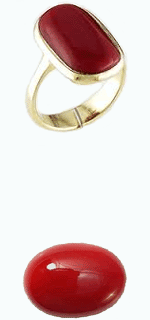| Colors: |
Seen in a range of warm pinkish to red colors, including light-red to salmon, and medium-red to deep ox-blood red. Sometimes has streaks or spots of white to pink. Can also be found in other colors such as gold, white, black and blue. Gold colored coral from Hawaii is extremely rare;Black and blue coral is not often used for gems or jewelry. |
| Shapes: |
Usually cabochon, with ovals, rounds and free-form shapes being the most popular. |
| Origin: |
Most of the precious coral available today is harvested from the western Mediterranean Sea, especially in Sardinia. Notable deposits are also found in the Bay of Biscay, Malaysian Archipelago, Midway Islands, Japan, Australia and the Hawaiian Islands. |
| Care: |
Wipe down precious coral using a soft cloth and a mild soap or detergent if needed. Rinse well using room-temperature water to remove soapy residue. |
| Notes: |
Among the Hopi and Zuni tribes, the 'road of life' is symbolized by coral, jet, abalone and turquoise (the four elements). Coral is said to be the favorite gemstone for Mermaids. |

